Brentford have long been lauded as one of the smartest clubs around in terms of their recruitment. They use data extensively as a part of their recruitment process and this process is supported by the use of bespoke models that are created and implemented by staff both at the club and at the betting company Smartodds, a company that is run by the Brentford owner Matthew Benham. These models and the use of data have allowed Brentford to identify and sign young players that have improved their first-team before being sold on for a significant profit for several seasons now.
Indeed, if we look back over the recruitment at Brentford since the 2017/18 season we begin to see a picture of staggering success. Ollie Watkins was signed for £6.5M from Exeter City and then sold to Aston Villa for £30.6M and Neal Maupay was signed for £1.8M from Saint-Etienne and then sold to Brighton for £20M two years later. Fast forward to the 2018/19 season and we see that Ezri Konsa was signed for £2.57M from Charlton Athletic before being sold for £11.97M to Aston Villa for while Said Benrahma arrived from Nice for £1.53M before departing for West Ham for £20.79M. As we move forward to the 2019/20 season we see the value that Brentford extracted from the market has continued with a number of signings that provide the core of the current squad. Electric attacker Bryan Mbeumo arrived for £5.85M from Troyes. Goalkeeper David Raya was a £3.02M signing from Blackburn Rovers. Defensive rocks Pontus Jansson and Ethan Pinnock arrived for £5.54M, from Leeds United, and £3.02M, from Barnsley, respectively whilst midfielders Mathias Jensen and Christian Norgaard arrived for £3.42M, from Celta Vigo, and £3.15M, from Fiorentina. Even last season we still see evidence of incredible foresight from a recruitment perspective as Ivan Toney arrived for £5.04M from Peterborough and Vitaly Janelt arrived for just £540K from Bochum.
For a club to have two to three seasons in which their recruitment is smart and effective is impressive. For a club to be as consistent as Brentford have been is nothing short of remarkable, especially when you consider their stature and financial strength in relation to some of the teams that they were competing against in the English Championship. All of this player trading and talent identification finally came to a head when at the end of the 2020/21 season we saw Brentford promoted to the Premier League as they won the playoff final against Swansea City.
The promotion of Brentford raised some interesting questions. Could they as a club continue to identify and procure talent at the same rate as their profile was raised by their presence in the Premier League? Playing in the top-flight of English football did after all come with significant financial gains and that in turn could see potential selling clubs add a premier league tax to the asking price of any deal. This was combined with the further complication added by Brexit as the need to qualify for a GBE permit in order to play in England would limit the depth of the markets that Brentford could now shop in.
The purpose of this article is to look at three of the signings that Brentford have made prior to the start of the 2021/22 season to examine first of all if their Premier League status has had any impact in terms of the prices that they are paying and also to see if they have continued with their policy of signing players that still have development potential.
Signing #1 Kristoffer Ajer, Celtic and Norway, £14.13M
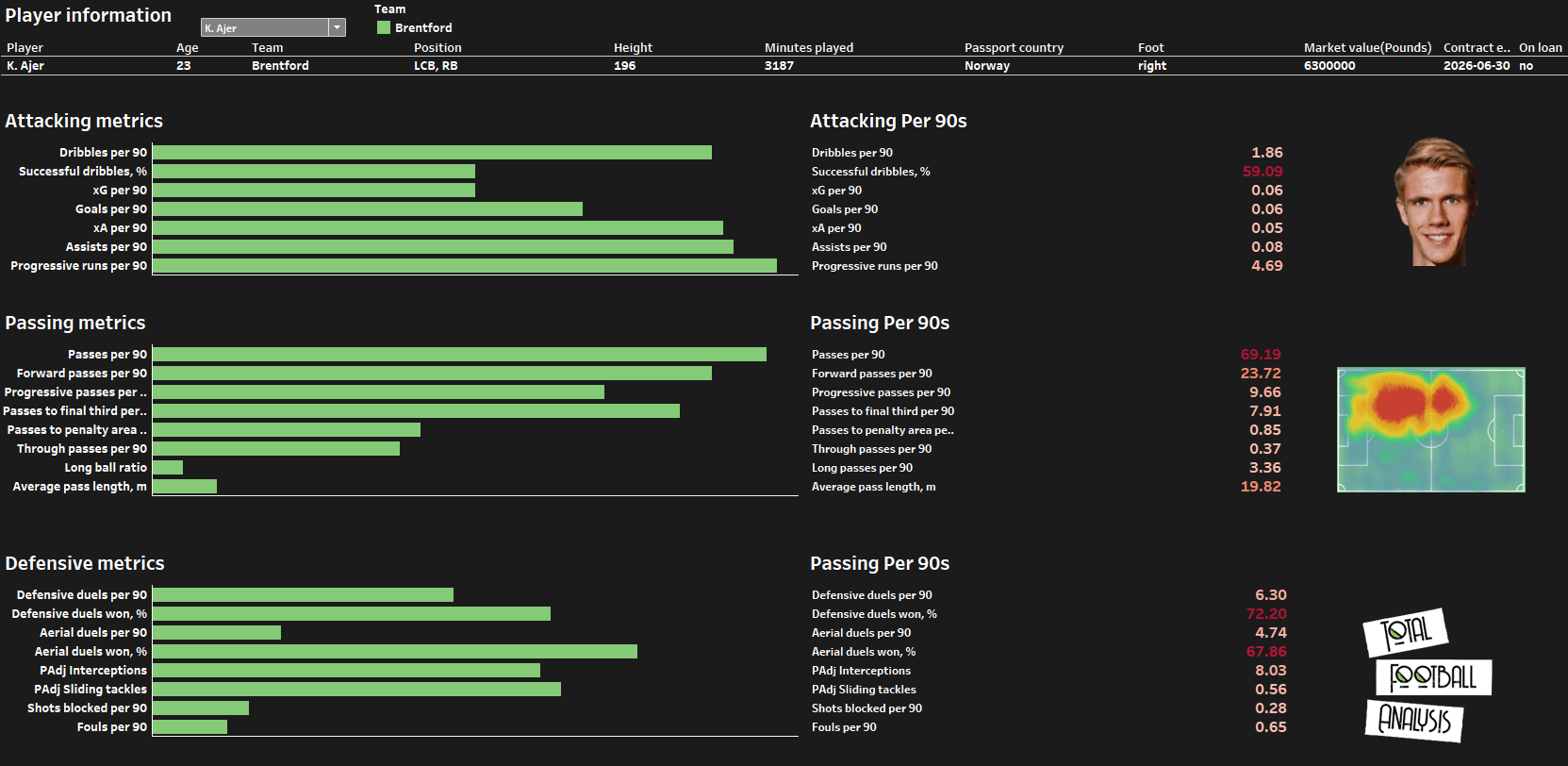
First of all, we have the signing of the Norwegian international central defender Kristoffer Ajer from Celtic for a reported £14.13M. Ajer is a prototypical ball-playing central defender who is right-footed but spent the majority of last season playing as the left-sided central defender for Celtic. He is capable of playing as a central defender in a back three or in a back four but could also fit in as a ‘6’ at a push.
Ajer’s data profile (above) is interesting as for a central defender his outputs are skewed to the attacking side, this is a result of how possession dominant Celtic are in the SPFL. Last season he averaged 1.86 dribbles per 90 with 4.69 progressive runs per 90. This fits his profile as a central defender who will carry the ball regularly into the opposition half as he looks to progress his team forward and force the opposition to break out of their defensive shape to press the ball.
As well as impressing with his ball-carrying ability Ajer also posted good passing numbers last season with 69.19 passes per 90 9.66 progressive passes per 90 and 7.91 passes to the final third per 90
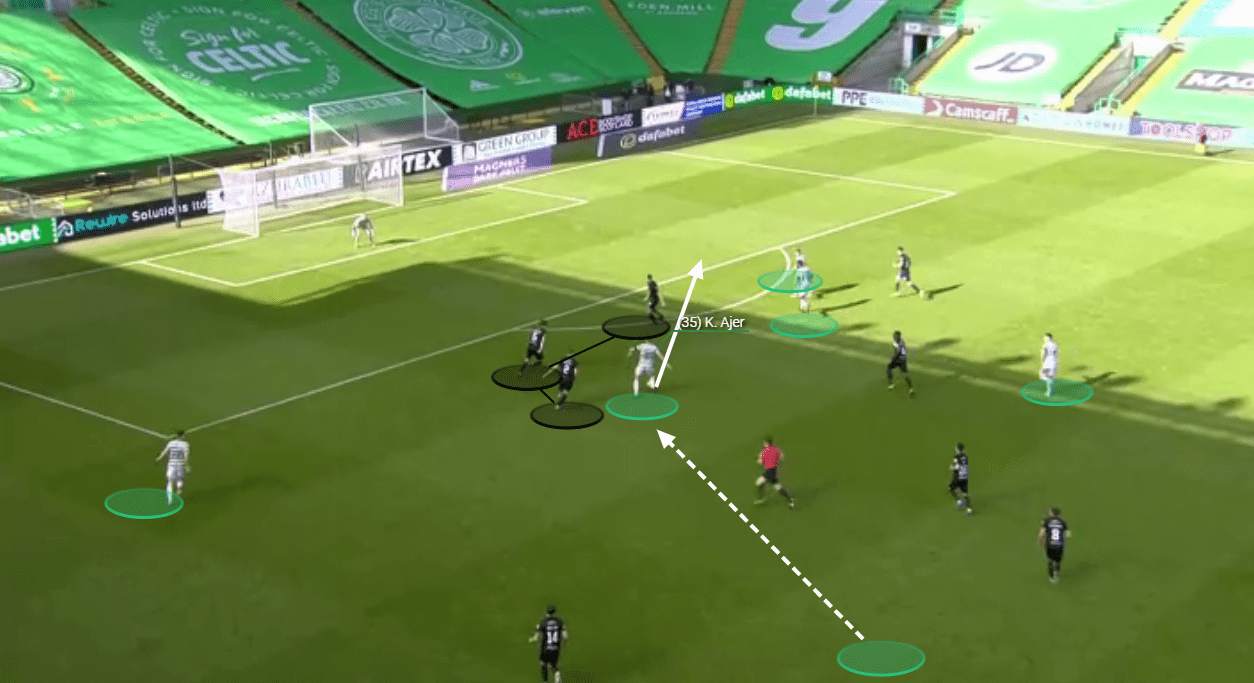
Here, we see an example of his ability to carry the ball forward into dangerous areas and the chaos that this causes for the opposition defensive structure. Here, Ajer has carried the ball all the way to the edge of the Livingston penalty area until he is faced with three defensive players who are moving in a compact block. In this situation, we would generally see central defenders become rushed or flustered in terms of making potentially poor decisions or in rushing a shooting opportunity. Ajer, however, is always very calm in possession of the ball and he simply waits for the defenders to commit towards him before he then slips the ball sideways to release the forward.
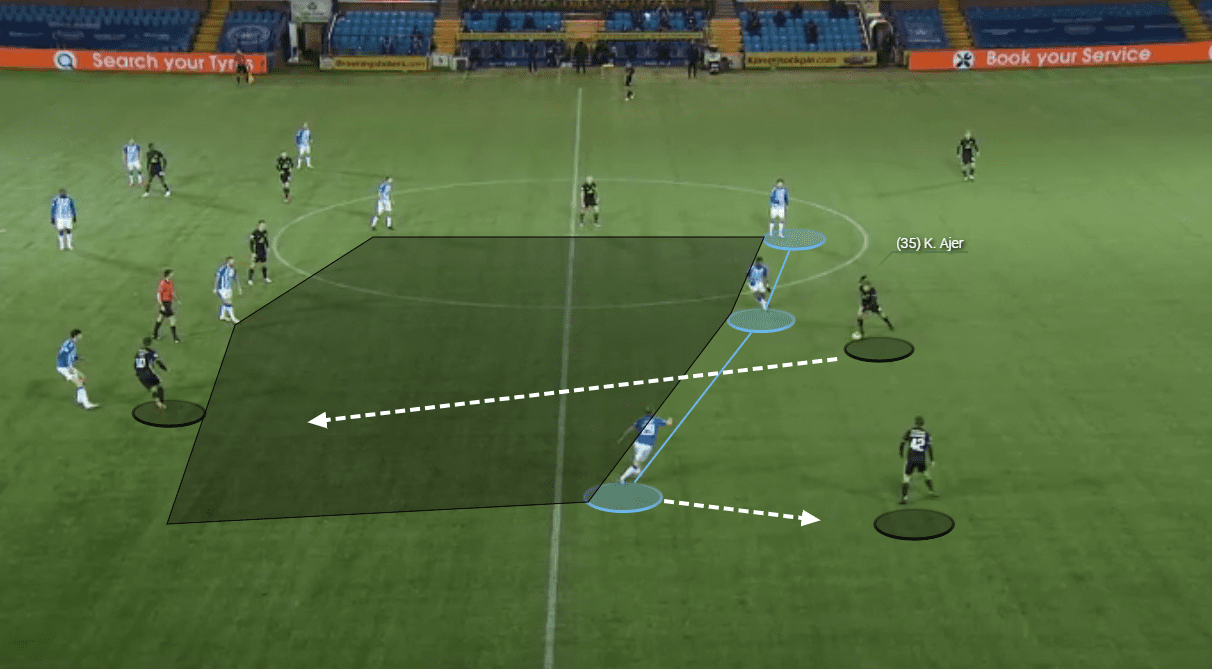
Here, we see another example of Ajer carrying the ball into dangerous areas. This time as he steps out from the defensive line to break a high press. As he is on the ball he shapes to pass out to the left-back and the Kilmarnock attacker is attracted forward to close down this option.
Ajer simply uses his pace to step out from this position and attack the space between the Kilmarnock midfield and the attack. Once again his pace when carrying the ball allows him to move to a higher position quickly and before the opposition can react
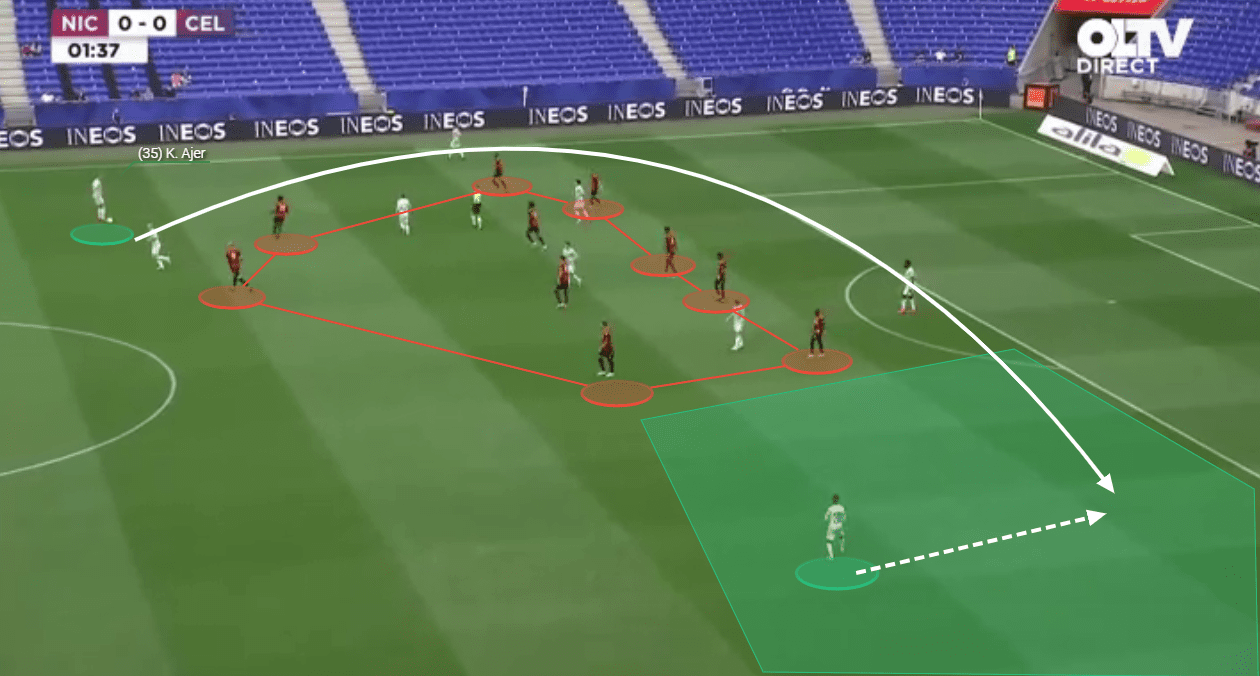
As well as being capable of carrying the ball into dangerous areas Ajer is also a threat with his passing range as he displays the capability to access all areas of the pitch. We see an example of this above as Ajer receives the ball early in the match between Celtic and Nice. The French side are positioned in a compact block against the ball. When Ajer receives the ball he is not put under any direct pressure and as such he is capable of switching the attack with a diagonal pass that accesses the player in space on the near side.
So, the signing of Ajer seems to make a lot of sense for Brentford as his versatility allows Thomas Frank to play in a back three or a back four. His ball carrying and passing ability will also be extremely important in terms of progressing the ball through the thirds at the Premier League level.
Signing #2 Frank Onyeka, Midtjylland and Nigeria, £9M
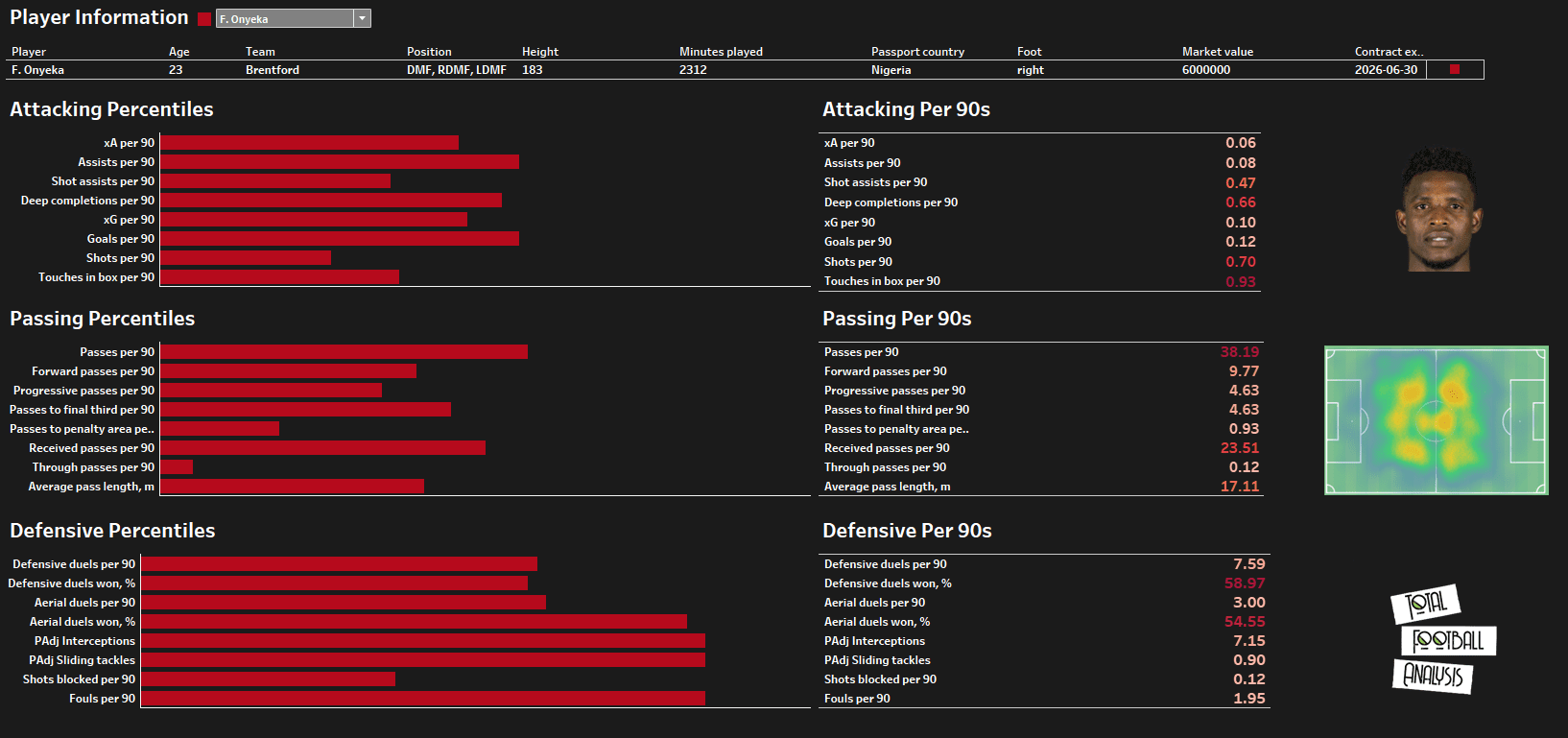
The deal to sign Frank Onyeka from Midtjylland is potentially a little messy given that the Danish side is also owned by Matthew Benham with Rasmus Ankersen holding key posts in terms of recruitment and strategy at both teams. With that said, however, a fee of £9M certainly appears to represent genuine market value. Onyeka profiles as a box to box midfielder with the capacity to effectively contribute in the attacking and defensive phases of the game.
Last season he averaged 0.70 shots per 90 and 0.93 touches in the opposition area per 90. These attacking metrics are reasonable but in truth, he was at his most effective when progressing the ball through the thirds. He averaged 23.51 received passes per 90 with 4.63 passes to the final third per 90.
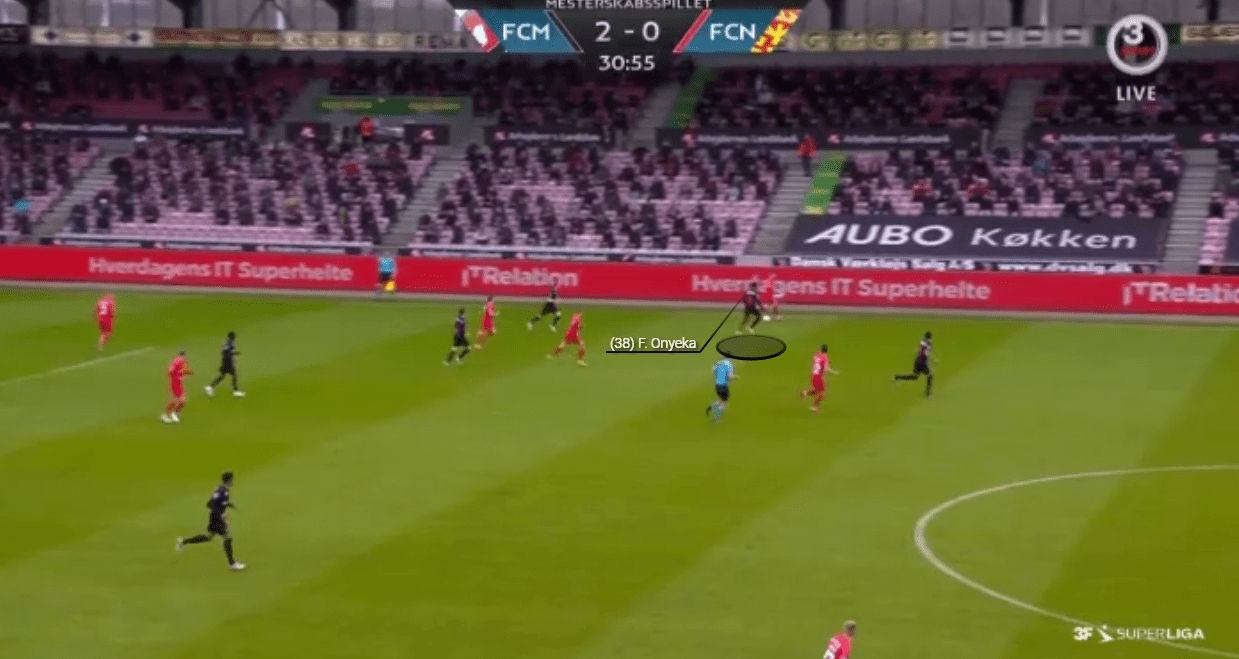
Onyeka is an effective player in the midfield area when facing defensive transitions. He reads the game well and has strong defensive instincts which allow him to position himself well when facing opposition players. We see an example of this here as the opposition are looking to transition and attack down the outside of Onyeka. He reads the intention of the opponent well and not only matches the run but is able to win the ball back cleanly for his side.
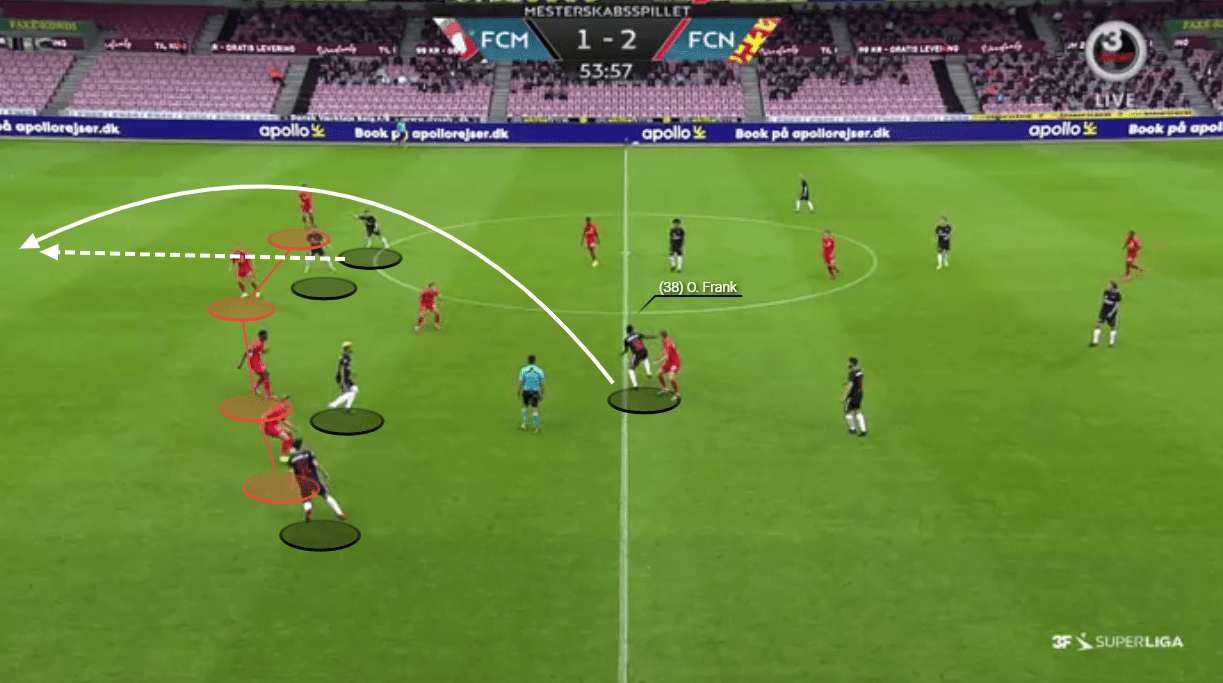
Onyeka also displays the capacity to make good decisions when in possession of the ball and when he wins the ball back for his side and launches an attacking transition. We can see an example of that above. The ball had been loose in the midfield and Onyeka steps in to win the ball and secure possession. As he does so the attacker on the far side immediately makes a forward run that breaks the line of the opposition defence. Onyeka has the technical ability to find the runner.
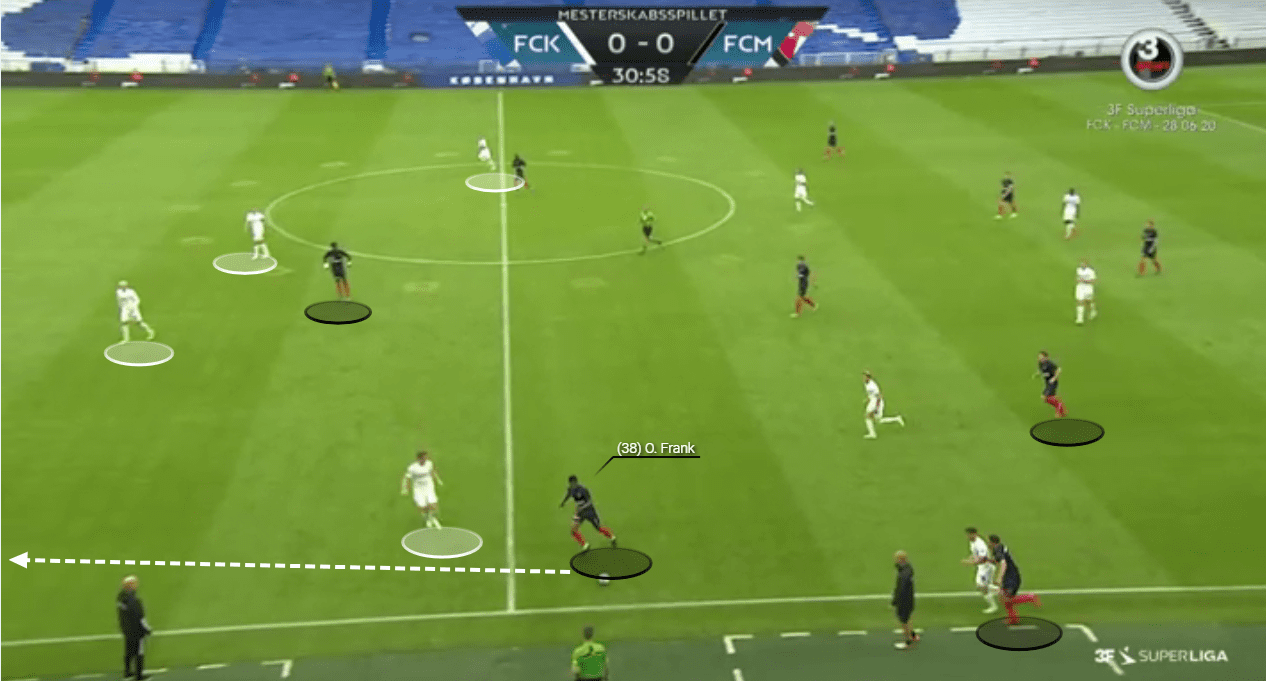
Onyeka is also impressive when using his strength and speed to carry the ball in transition to move the ball cleanly through the thirds. Here we see him in possession wide on the near side and as the opposition player looks to get close to the ball Onyeka is strong and fast as he times his movement to attack down the outside.
The signing of Onyeka to play in the midfield makes a lot of sense for Brentford as he brings a profile to the midfield that they did not have previously. He compliments the passing of Jensen and Norgaard very well.
Signing #3 Yoane Wissa, Lorient and DR Congo, £9M
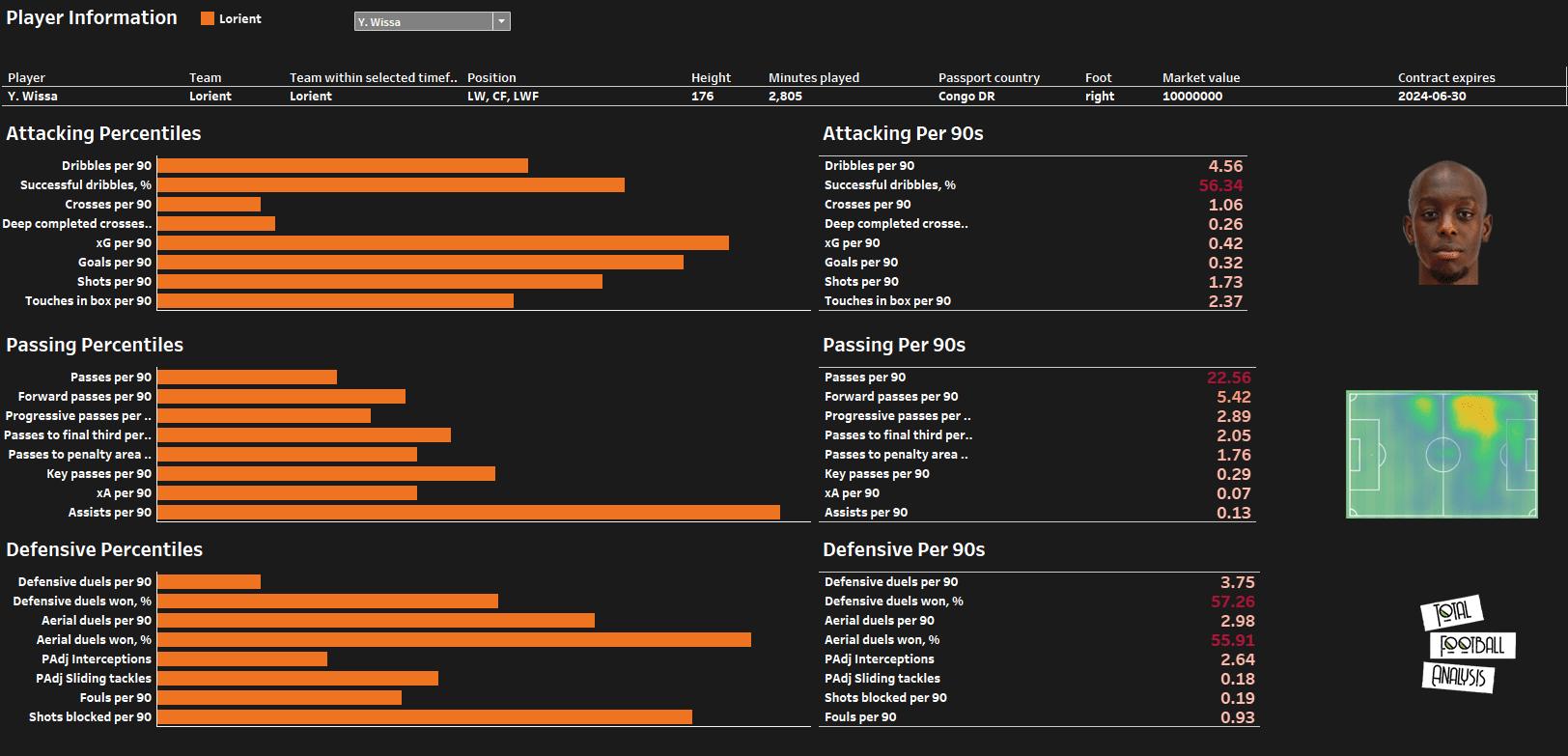
The final of the three players that we will cover in this article is Yoane Wissa who Brentford signed from Lorient for a reported £9M. Brentford know the French market well and they look to have used this knowledge to secure another exciting attacking talent in the 24-year-old Wissa.
Last season he averaged 0.32 goals per 90 from an expected goals of 0.42. He also averaged 1.73 shots per 90 and an average of 2.37 touches in the opposition area. Interesting attacking metrics for a player coming to the Premier League.
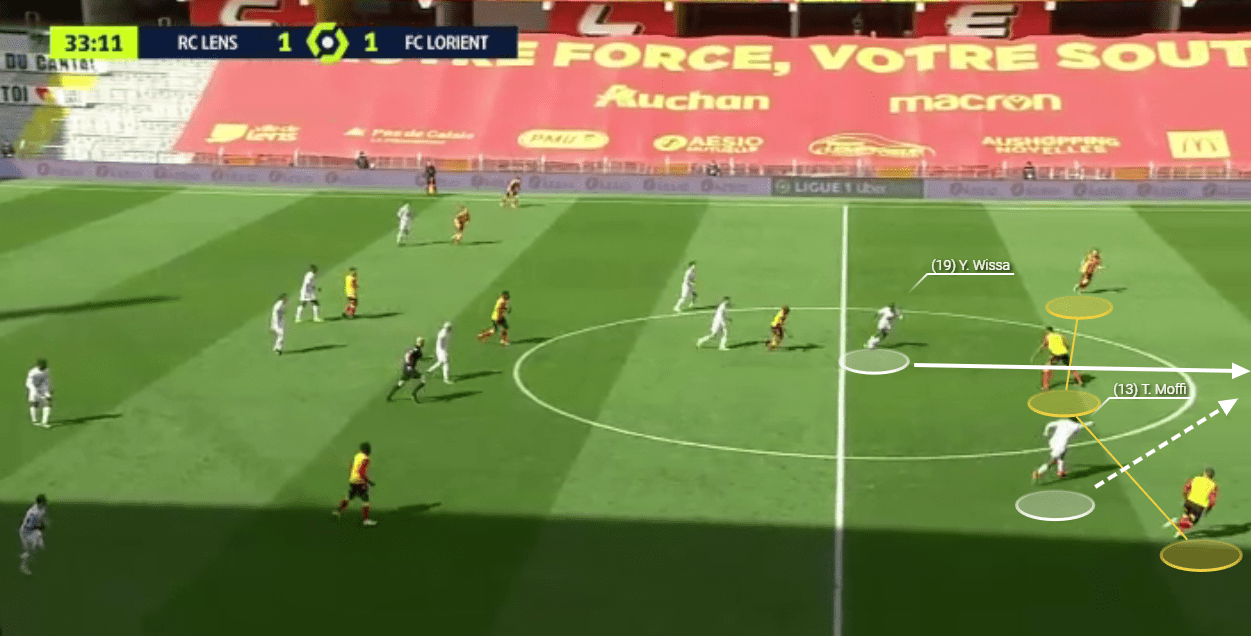
Wissa is a creative passer who plays well in attacking transitions with obvious footballing intelligence. He can carry the ball well at pace and he releases the ball in intelligent positions to play in teammates. This is a trait that will work well with Wissa and either Mbeumo or Toney in the attacking structure. We can see here that Wissa is positioned centrally as he picks up the ball with Terem Moffi making a good and intelligent run diagonally. Wissa does not hold the ball for longer than is necessary but instead releases the ball through the defensive line perfectly weighted.
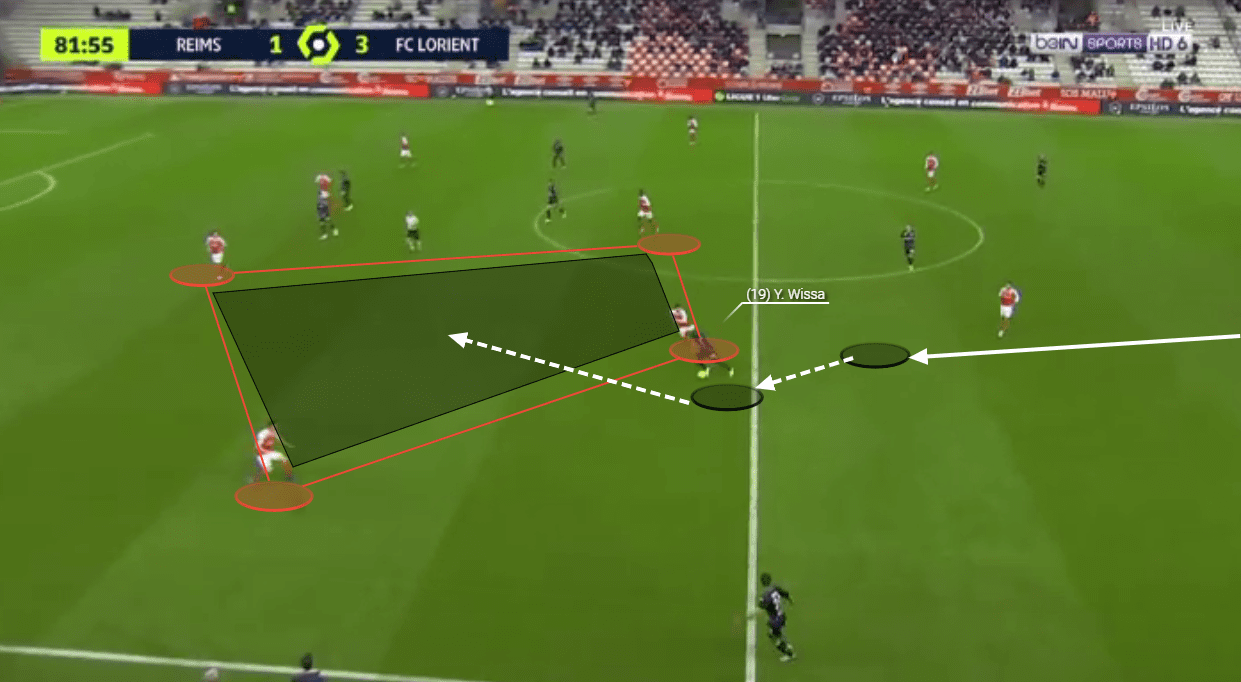
Wissa picks up the ball in deeper areas before progressing the ball effectively through the thirds. He is a quick ball carrier who has great balance and the ability to take touches with either foot. Here, we see Wissa having taken the ball inside his own half facing his own goal. As he collects the ball he spins and can attack the space in the opposition half.
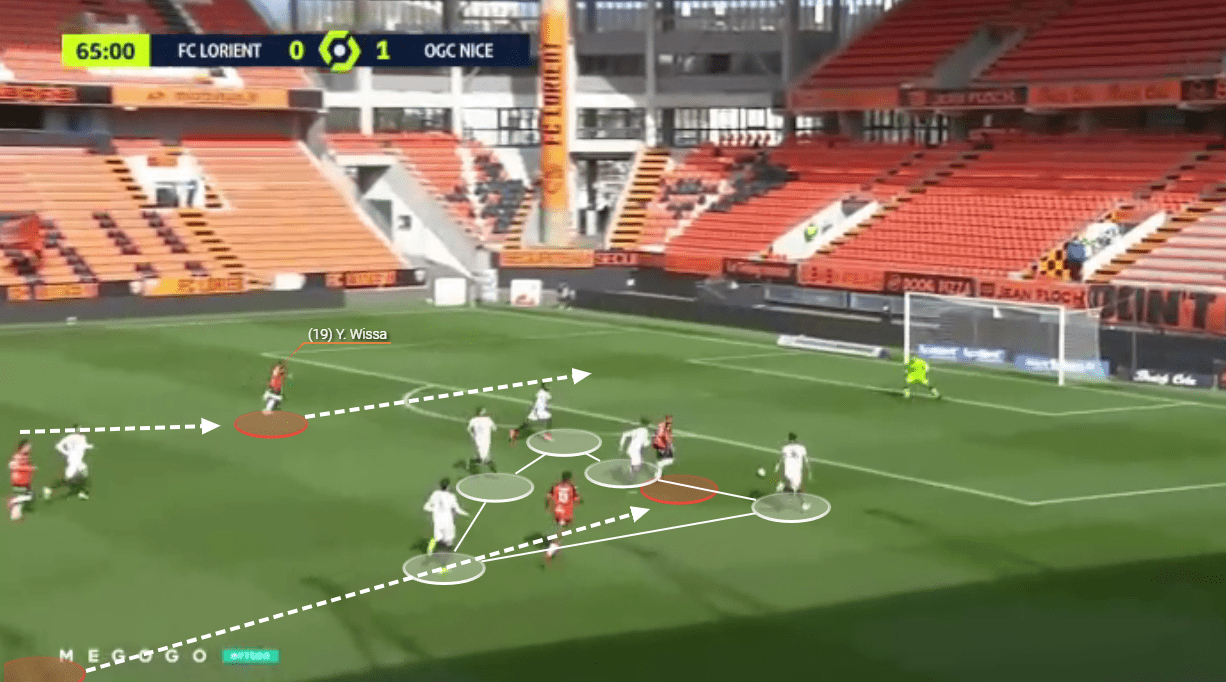
Wissa makes intelligent movements off the ball and displays a tendency to make good movements to create goal-scoring opportunities for himself. We see an example of this here as a teammate has carried the ball 60 yards to be on the edge of the opposition penalty area. Wissa holds his position and is not attracted to the ball. Instead, he stays wide and when the ball is played across he can finish easily at the far post.
Wissa, again, feels like an intelligent signing as a backup option to the likes of Mbeumo in particular. His goal output and intelligent positioning should work well in the Brentford attacking structure.
Conclusion
While there can be no doubt that Brentford have had to pay higher fees this season than they have in the past to get their targets there is still a sense of control about their performance in the transfer market. They have identified players who are just at the start of their peak years and who will likely have resale value and players whose profiles either fit the structure or offer something slightly different to what the club already had.
Brentford are one of the most intelligent sides in football, and now they are ready to establish themselves at the Premier League level.






Comments